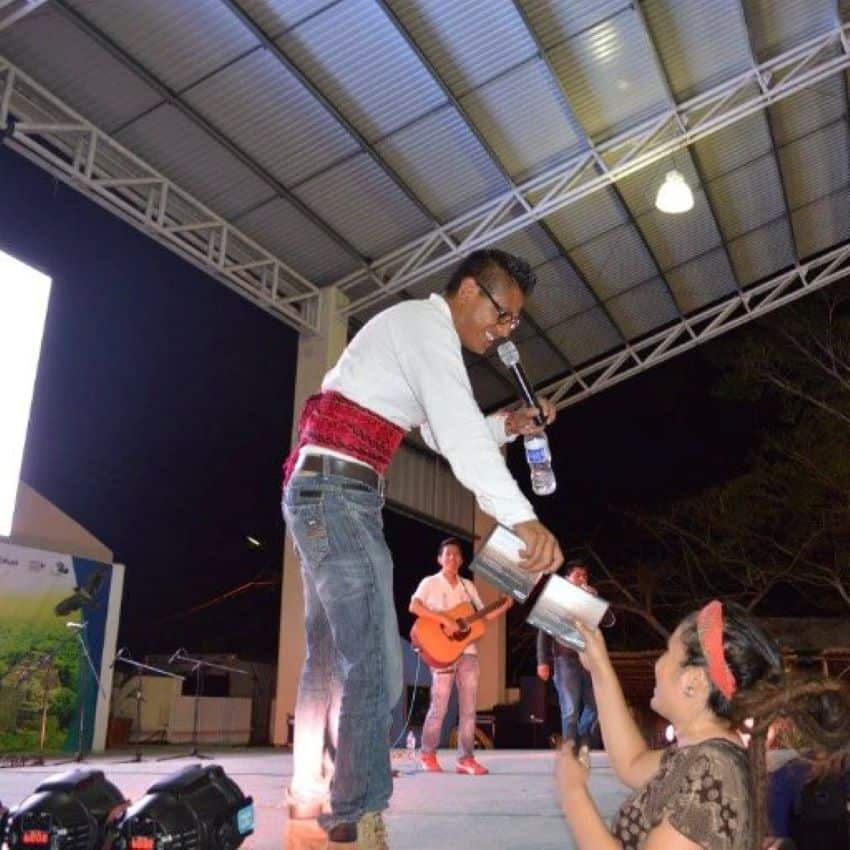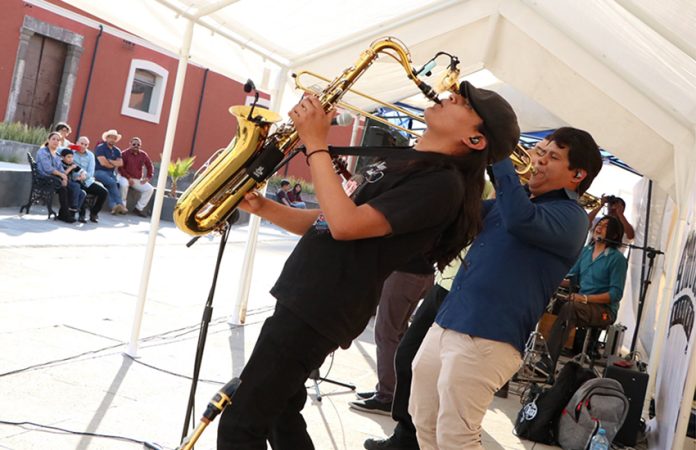It is too easy to think of indigenous communities as never-changing living museums; certainly Mexico’s decades of tourist promotion gives that impression. But the truth is that indigenous cultures change — and wrestle with various conundrums as they do so — just like the rest of the world does.
Those conundrums include generation gaps, as young people are more open to the outside influences that globalization brings to indigenous communities.
But there is some difference. Indigenous cultures were suppressed for centuries after the Conquest.
The Mexican Revolution brought about the notion that Mexican identity was a mix of Spanish and indigenous ones, but even this way of thinking — as radical as it was for the time — did not appreciate the diversity of cultures in Mexico.
Today, many indigenous communities cannot be distinguished readily from others by appearance (dress) nor sound (language), a sign of their absorption into the mainstream.

Indigenous youth interested in playing rock, rap, jazz, and other genres have faced pushback from their own communities that feel threatened by it. Even non-indigenous people can feel awkward about the idea, as it challenges the notion that these cultures’ preservation is about a lack of change and the need to be as different from the non-indigenous as possible.
But indigenous cultures have always changed over time. The introduction of European culture after the Conquest irrevocably changed (surviving) indigenous cultures centuries ago, producing many of the traditional music and other cultural expressions that are presented as authentic culture today. That included the introduction of a myriad of instruments such as violins and guitars, along with rhythms, scoring and even the idea of music for secular purposes.
Even as late as the early 20th century, the waltz found its way into some indigenous communities’ repertoire.
But does the adaptation of rock, ska, reggae, rap, hip-hop and even Mexican norteño music threaten indigenous cultures or provide new tools to continue them?
That question can be answered definitely only by the communities in question, but I have to wonder why the idea of a Chontal Maya speaker rapping, for example, seems stranger than the same person creating digital art with iconography from that same culture.
The young people who use outside musical styles do so not to reject their heritage but to preserve it. And their most important efforts are linguistic.

Many of these musicians sing wholly or in part in the language of their communities, something that is vital since of the 63 indigenous languages (and 350 dialects thereof) recognized by the Mexican government, most are in danger of disappearing.
Many young people do not use their indigenous languages outside of their families because of discrimination or because they do not see it as relevant to the modern world. Musicians singing in indigenous languages consider themselves activists striving to keep these languages alive.
In addition, the lyrics they write talk about their communities’ cultures as well as sociopolitical issues. The latter is particularly true for those who perform rap and hip-hop, such as two different Sonorans — Janeidy Molina and Zara Monrroy, both working in the language of the Seri people (also known as the Comcaac).
The popularity of the bands and the types of venues in which they play range from a very local phenomenon to those who play to sizable crowds all over Mexico. Examples of indigenous language bands with a regional and even national following include Isaac Montijo y Los Buayums from Navojoa, Sonora, which mixes various musical styles; Kjimi Kjuarma, from México state, which performs rock and rap; and Los Juchilangos of Oaxaca and Mexico City, which performs jazz and ballads.
These bands have found allies in government, academia and NGOs, mostly through promotion at cultural festivals such as the Festival of Hip-Hop in Indigenous Languages in Mexico City. Another extremely important tool for these groups is social media, particularly YouTube, Facebook and Spotify.
Mexico’s National Institute of Indigenous Peoples (INPI) has long provided selected groups with grants for travel, costumes, equipment and more. They began recording and documenting emerging musical styles in indigenous communities as early as the 1990s.

INPI’s head archivist, Octavio Murillo, says documenting these bands’ work is important because it “… promotes pride; original peoples can recreate and reevaluate themselves in each performance.”
INPI’s efforts to keep its archives current have included recording an album/book of music by 12 bands entitled Vuelo sonoro: Músicas alternativas de jóvenes indígenas (Resounding Flight: Alternative Music of Indigenous Youth). The album includes Afro-Caribbean, norteño and rock and hip-hop compositions in languages such as Náhuatl, Tepehua, Mayan and Zapotec.
The bands include La Murga Xocohtl (norteño in the Náhuatl language), Nuk Yinik Prehispanica (lyrics in various musical styles in the Tabasco Chontal Maya language) and Tachapunk (punk, hard rock in the Tepehua language).
Murillo states that the project and continuing support for these artists are vital to keep their archives and general knowledge of indigenous communities “up to date.”
• Vuelo Sonoro was not created for sale. Nonprofit agencies or media can request a copy by emailing Murillo.
Leigh Thelmadatter arrived in Mexico 18 years ago and fell in love with the land and the culture in particular its handcrafts and art. She is the author of Mexican Cartonería: Paper, Paste and Fiesta (Schiffer 2019). Her culture column appears regularly on Mexico News Daily.
